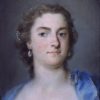Besides Giambattista Tiepolo, other important Venetian fresco painters participated in the decoration of the wedding apartment. This room was decorated by Gaspare Diziani, one of the most active mid-18th century artists in this field. On the ceiling he painted a theme which was particularly dear to Venetian nobility, the Triumph of the Arts over Ignorance.
Diziani presents us with a swarm of allegorical figures, each one holding the tools of his particular art and painted in the warm, bright colours learnt from his master Sebastiano Ricci.
On the walls are a collection of portraits in pastels, a technique which originated in France in the Renaissance but which reached its peak during the 18th century. The particular features of pastels, applied to a paper or cardboard support, are their softness, rapid use and the possibility of overlapping various layers of colour. This allows perfect reproduction of texture, and particularly of human skin, which caused it to become the favourite technique for portraits.
Although the pastel technique originated and flourished in France, it was the Venetian woman artist Rosalba Carriera who exploited it to its utmost, and gave it a more modern, striking texture. The work of Rosalba Carriera, the most famous Italian woman artist in Europe for the whole of the 18th century, is exemplified in the portrait to the left of the door you came in by, Portrait of gentleman in red, where she captures the main features of the subject’s personality, depicting his fleshy, wilful mouth and penetrating gaze. The scintillating tones of the pastels light up the whole picture and the impact of the image is increased through the contrast of the vermillion jacket and the luminous face.
On the wall to your right, past the door which leads onto the Portego (large central hall), another two of her masterpieces are displayed: the Portrait of Sister Maria Caterina and Portrait of the contralto Faustina Bordoni Hasse. Comparing the two, we can perceive Rosalba’s mastery of differing emotional registers, her exceptional skill in interpreting the human soul. We see the benevolent spirituality of the nun, who died in the odour of sanctity in 1734, contrasted with the energetic, shrewd expression of the singer, who was a real primadonna, a protagonist of 18th-century opera.
The fine portrait in the middle of the following wall is by Lorenzo Tiepolo. It shows his mother Cecilia Guardi Tiepolo, the wife of Giambattista Tiepolo and the sister of Antonio and Francesco Guardi. Notice in particular the delicate tones and the nuances of colour which make this painting, done when Lorenzo was only 21 years old, a work of refined quality.
The four small display cases along the walls contain porcelain from the collection of Marino Nani Mocenigo. Particularly noteworthy are the pieces belonging to a Coffee, Tea, and Chocolate set with bird and rock décor in gold on a blue background, also known as Hausmaler, from the Meissen manufactory.



